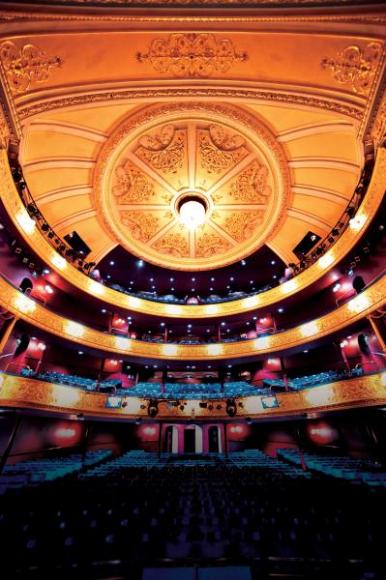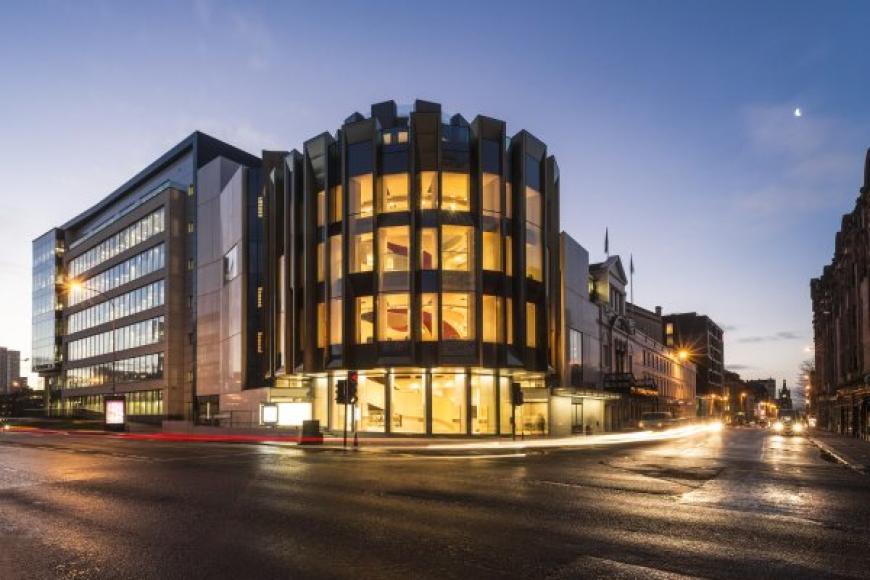Theatre Royal
The Theatre Royal in Glasgow is the city's longest serving theatre. Opened by James Baylis in 1867, it became the flagship and birthplace of Howard & Wyndham Ltd in 1895. In 1957 it became the Scottish Television Theatre, serving as TV studios for the newly formed STV. The theatre was offered by STV to Scottish Opera in 1975 and subsequently transformed into a magnificent venue for opera and ballet. This is the largest and among the finest theatres by Phipps to survive. The theatre has a painted stone exterior. The entrance was once distinguished by a tower with a dome, now truncated, and a massive glazed full-length canopy, long-since removed. The Hope Street foyers were refurbished in the 1970s in an elegant pastiche of the Phipps manner. In 2014, a new main entrance and foyer was created on the corner of Hope Street and Cowcaddens Road. This new curved extension has a metal clad concrete frame with glass panels. It is described by its architects PagePark as an "illuminated lantern" and gives the theatre a more dramatic presence in the streetscape. Ranging over four floors and linked by central spiral staircases, the new foyers have enabled lifts to be added, improving access to the auditorium at all levels. Other new facilities include education rooms and a roof terrace. The auditorium, which was refurbished in 1997, is a delight. Three balconies - each of about eleven rows - the first with a serpentine front and the upper two horseshoe, were originally fully supported by iron columns, some of which have been removed and cantilevers inserted. The balcony slips meet superimposed stage boxes set between pairs of giant Corinthian columns with enriched shafts. The entablature continues the line of the third balcony front and has a richly decorated frieze which returns above the rectangular proscenium frame. The tympanum takes the form of a deep elliptical arch. Coves above carry a stately panelled circular ceiling with fine gilded decoration. Indeed, the whole space positively glows with gilt on ivory and rich blue upholstery. The decoration on the balcony fronts is a delicate combination of Renaissance strapwork and Rococo and is of exceptional quality. The Theatre Royal feels like a miniature version of grand European opera houses and has fulfilled its role very well.
Further details
- 1867 Design/Construction:George Bell- Architect
- 1867 Owner/Management: James Baylis
- 1869 Owner/Management: William Glover & George Francis
- 1878 Owner/Management: William Glover
- 1880 Alteration: rebuilt after fireC J Phipps- Architect
- 1880 Owner/Management: Marie Litton
- 1881 Owner/Management: Charles Bernard
- 1882 Owner/Management: Glasgow Theatre & Opera House Co
- 1884 Owner/Management: Fred Sydney
- 1885 Owner/Management: Edward Lee Knapp
- 1887 Owner/Management: William Thomas Rushbury
- 1888 Owner/Management: James Howard & Fred Wyndham
- 1895 Alteration: rebuilt after further fireC J Phipps- Architect
- 1895 Owner/Management: Howard & Wyndham Ltd
- 1907 Alteration: Keppie & Mackintosh, incorporation of former tenements on Hope StreetHoneyman- Architect
- 1957 Owner/Management: Scottish Television
- 1972 Design/Construction:
- 1975 Alteration: restored and modified as opera houseArup Associates (Derek Sugden)- Architect
- 1975 Owner/Management: Scottish Opera
- 1997 Alteration: refurbishedLaw & Dunbar-Nasmith- Architect
- 2005 Owner/Management: Ambassador Theatre Group, management.
- 2014 Alteration: New foyers addedPagePark- Architect
- CapacityOriginalDescription1,950 prior to 1957
- CapacityLaterDescription1912: 2,185
1946: 1,951 - CapacityCurrentDescription1547
- ListingA



